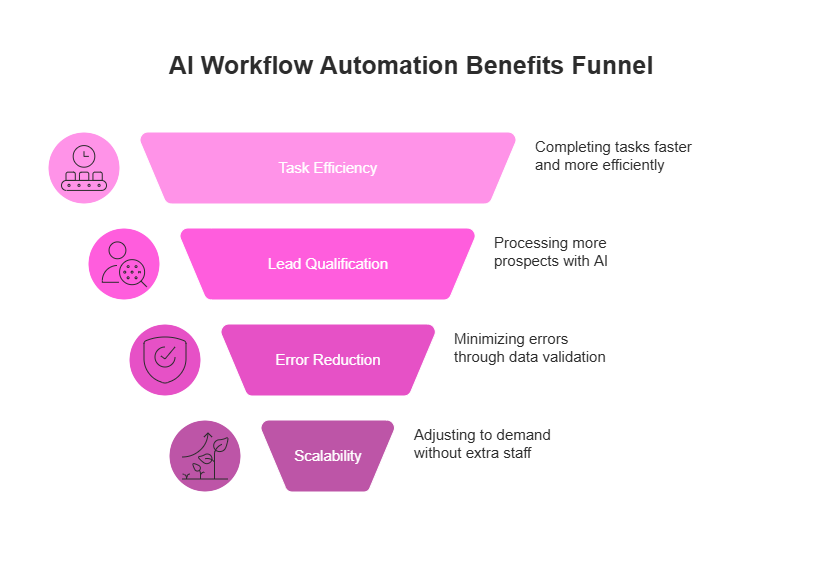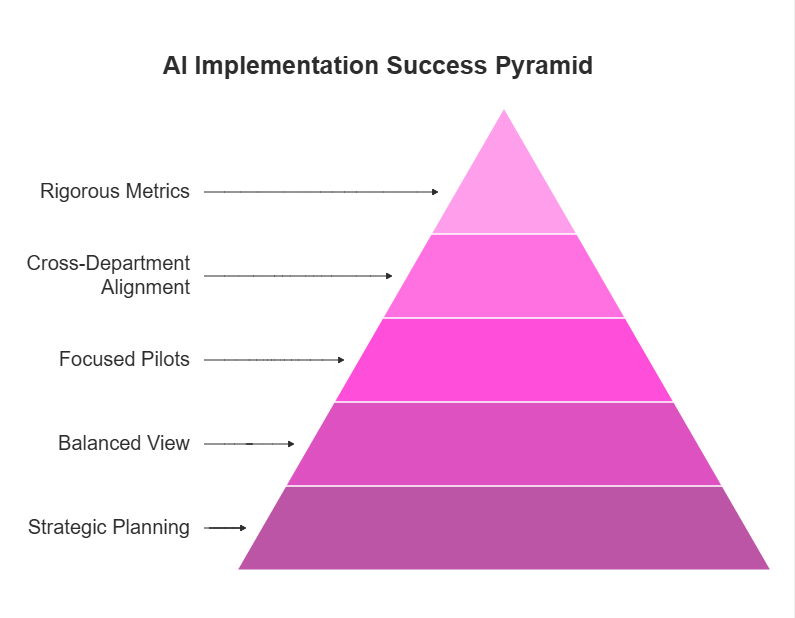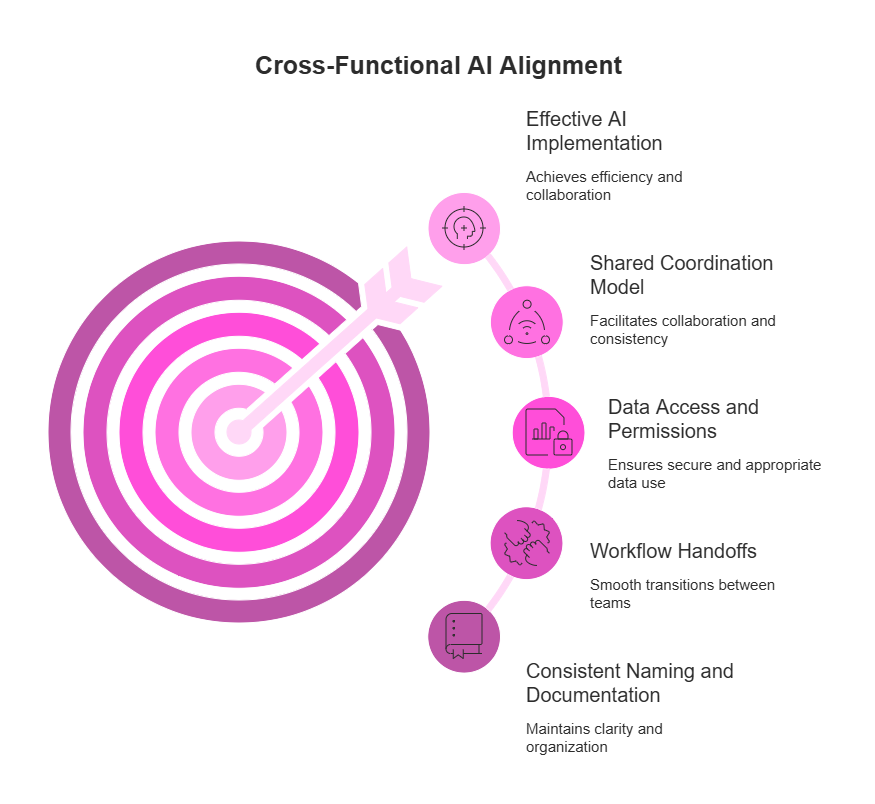This article explores how AI workflow automation transforms B2B operations in 2025. Manual processes waste resources and create bottlenecks that AI solutions effectively eliminate. We examine the shift from traditional automation to intelligent workflows that adapt and learn over time.
Data shows companies using AI workflows see dramatic improvements – from 35% higher engagement rates to 260% increases in conversions. This guide provides a roadable roadmap for B2B leaders ready to capture these advantages while avoiding common implementation pitfalls.
The Urgent Need for AI Workflow Automation in B2B
B2B companies struggle with fragmented processes, drowning in spreadsheets and manual tasks that waste countless hours. Data sits trapped in departmental silos while teams chase information across disconnected systems. This operational chaos costs more than time. It erodes competitive advantage in a market that rewards speed and precision.
Smart businesses recognize this reality. Statista reports that 45% of B2B companies have implemented AI solutions as of 2024, expected to reach 60% by 2026. Companies adopting AI workflows see 30% efficiency gains, 20% fewer errors, and 15% higher customer satisfaction.
For organizations still relying on manual processes, 2025 marks a critical decision point. AI workflow automation transforms scattered operations into streamlined systems that boost revenue and reduce costs. The good news? Platforms like Cubeo AI make these capabilities accessible without coding expertise, letting any team harness powerful AI use cases for their B2B operations.
What specific workflows deliver the greatest impact? Let’s explore the 10 essential AI automations every B2B company should implement this year.
Why AI Workflow Automation is Critical for B2B Success in 2025
Outdated manual processes drain our resources and stifle growth in B2B operations. Teams waste hours on repetitive tasks while vital information sits trapped in departmental silos. This fragmentation creates bottlenecks, delaying decisions and frustrating customers. Manual workflows introduce human error. They also create compliance risks. Scalability limitations become more problematic as our organizations expand.
A Gartner report predicts that by the end of 2025, 50% of B2B enterprises will adopt AI-driven automation, yielding $800 billion in operational savings. Their analysis of over 1,000 projects shows AI reduces time-to-market by 30%. Cross-department collaboration improves significantly too. For those of us still relying on legacy systems, this represents both a warning and an opportunity.
Market signals couldn’t be clearer about this trend. The market for sales automation will reach $16 billion by the end of 2025, according to recent studies. Already, 60% of organizations utilize AI-driven tools in their workflows. Delaying implementation puts us at risk of falling behind competitors who deliver faster, more personalized customer experiences at scale.
No-code AI platforms democratize access to these capabilities. Teams without technical expertise can now build powerful workflows. This accessibility removes traditional barriers to adoption. Organizations of all sizes can effectively compete in an increasingly AI-driven marketplace.
The Evolution from Manual Processes to AI-Driven Workflows
Traditional B2B operations rely heavily on spreadsheets and email chains. Manual data entry consumes countless hours of our workday. A typical approval process might involve five different people. It often requires three separate systems. Days of waiting create frustration for employees and customers alike.
Digital transformation initially focused on basic automation. Many solutions merely digitized broken processes without fixing fundamental inefficiencies. Modern AI workflows represent a quantum leap forward in this respect. Rather than executing predefined steps, AI systems orchestrate entire processes. They adapt to changing conditions and learn from outcomes.
Intelligent workflows connect previously isolated systems. Data flows seamlessly across departments. These systems anticipate needs, suggest next actions, and handle routine decisions automatically. This evolution transforms our B2B operations from reactive to proactive. We can allocate human resources toward strategic initiatives instead of administrative busywork.
Key Benefits of AI Workflow Automation for B2B Companies
AI workflow automation delivers measurable advantages that directly impact our bottom line. Tasks that once took days now complete in minutes. Sales teams using AI-powered lead qualification can process five times more prospects. They focus attention on the highest-value opportunities while AI handles the rest.
Error rates drop dramatically as machine learning validates data against established patterns. Anomalies get flagged before causing problems. This precision proves particularly valuable in complex B2B environments. Financial consequences of mistakes can be significant in our industry.
The scalability benefits deserve special attention from B2B leaders. AI workflows adjust automatically to changing volumes without requiring additional staff. This capability allows us to:
- Handle seasonal demand fluctuations without hiring temporary workers
- Enter new markets without proportional increases in operational costs
- Respond to unexpected opportunities without resource constraints
Most compelling for our business goals, organizations using AI report 10-20% increases in ROI alongside improved customer satisfaction. These gains stem from faster response times. More personalized interactions and fewer service disruptions create competitive advantages that compound over time.

What Makes an Effective AI Workflow for B2B Companies
B2B companies now transform their operations with smart AI workflows. These systems do more than follow basic instructions. They connect data processing, learning algorithms, and automated actions to tackle complex business challenges. In a way, they bridge gaps between previously disconnected systems while adding intelligence traditional automation simply can’t match.
We need to examine both technical foundations and business applications to understand these workflows properly. AI lead scoring statistics show that 75% of B2B companies using this technology see a 25% improvement in lead quality. Conversion rates also jump by 15%. These numbers actually prove how well-designed AI workflows deliver real business results.
What makes these implementations successful? They start with clear objectives. They incorporate appropriate data sources. They apply suitable learning models. Honestly, they also include mechanisms for ongoing improvement. Governance frameworks ensure ethical and secure operation while maintaining alignment with company goals.
The difference between basic automation and AI workflows becomes clear in handling exceptions. Traditional systems often break when facing unexpected scenarios. AI workflows adapt and learn from these situations. They become more valuable over time, which is pretty remarkable when you think about it.
Core Components of AI Workflows
Several essential elements work together in effective AI workflows. Data connectors form the foundation. They pull information from CRM systems, marketing platforms, and support tools. These connectors handle both structured and unstructured data while maintaining security.
The intelligence layer consists of machine learning models. They analyze patterns in historical data. They make predictions based on real-time information too. Depending on complexity, these models range from simple algorithms to advanced neural networks.
Trigger mechanisms start actions when specific conditions occur. For example, a lead might reach a qualification threshold. A customer might show signs of potential churn. These triggers connect insights to actions, so the workflow delivers tangible value.
Feedback loops might be the most important component, in fact. They incorporate human input and outcome data to refine the system. This human-in-the-loop approach balances efficiency with judgment. The workflows improve with each iteration as a result.
How AI Workflows Differ from Traditional Automation
Traditional automation follows fixed rules that can’t adapt to changing conditions. A standard lead routing system might assign prospects based only on geography or industry. In contrast, AI-powered sales workflows—part of a market projected to reach $6.5 billion by the end of 2025—continuously learn from performance data. They adjust their approach based on what works best.
Predictive capabilities set these systems apart too. Traditional systems react after events happen. AI workflows anticipate needs and opportunities before they arise. A sales enablement workflow might suggest personalized content based on recent prospect behavior. This approach increases engagement rates significantly.
Real-time decision making allows our AI workflows to process information instantly. This speed creates advantages in time-sensitive B2B scenarios. Responding to RFPs or addressing service issues happens faster and more effectively.
The most significant difference lies in how these systems improve. Traditional automation stays static until someone updates it manually. AI workflows analyze their own performance. They identify optimization opportunities without human intervention. This self-improving nature means the gap between AI-powered organizations and others grows wider over time, which is kind of amazing when you think about it.
10 Essential AI Workflows Every B2B Company Should Implement
B2B organizations now recognize that specific AI workflows deliver exceptional returns on investment. These strategic automations tackle common pain points while building competitive advantages at scale. According to recent research, 89% of leading businesses are investing in AI to drive revenue growth. In fact, implementation has become a business imperative rather than just another tech experiment.
Let’s explore ten high-impact workflows that serve as excellent starting points for companies at any stage of AI adoption. Each one addresses critical business functions where manual processes typically create bottlenecks or missed opportunities. By implementing these workflows systematically, we can transform operations while maintaining focus on what really matters: our strategic priorities.
Lead Generation and Qualification
Machine learning engines scan prospect data continuously to identify patterns matching our ideal customer profile. Studies show 68% of sales teams use AI weekly, which honestly results in pretty impressive productivity gains – around 47% – by prioritizing high-potential opportunities. Teams waste less time on poor-fit leads and focus more on conversion-ready prospects.
Personalized Content Creation and Distribution
Content creation becomes more efficient with AI assistance. Large Language Model Optimization (LEO) frameworks complement SEO to improve discoverability across both traditional search and AI interfaces. Research agents automatically pull industry trends and competitor insights. These tools generate targeted drafts tailored to specific buyer personas, which basically accelerates production while maintaining quality standards.
Customer Support and Service Automation
Smart chatbots now handle routine inquiries around the clock, providing instant responses to common questions. They gather context for human agents when necessary. This approach ensures customers receive immediate assistance at any hour. Human touch points remain available for complex issues that require empathy or creative problem-solving.
Sales Pipeline Management and Forecasting
Historical CRM data feeds into AI systems that generate probability-based forecasts and analyze conversation patterns to spot potential deal risks. Sales leaders can make data-driven decisions about resource allocation and pipeline management. It’s almost surprising that 79% of leaders view AI as essential to their sales strategy, but the results speak for themselves.
Meeting Scheduling and Follow-up Automation
Calendar events trigger automated workflows that send meeting invites, reminders, and post-meeting summaries. During calls, the system captures action items and assigns follow-up tasks automatically. Nothing falls through the cracks anymore. Busy teams experience reduced administrative overhead, which frankly allows more time for high-value activities.
Data Analysis and Business Intelligence
Multiple sources feed into automated data pipelines that collect, cleanse, and analyze information continuously. Real-time dashboards present actionable insights without manual effort. Trends and anomalies that might otherwise remain hidden in spreadsheets become visible. Teams can actually respond to market changes faster with this continuous intelligence.
Email Marketing Personalization
Individual recipient preferences shape dynamic content blocks that adapt automatically to behaviors. Subject lines created with AI assistance boost open rates significantly. Ongoing A/B testing optimizes messaging without manual intervention. In a way, this explains why companies leveraging AI for personalization see a 35% increase in engagement rates compared to static campaigns.
Customer Onboarding and Success
Customer profiles and usage patterns inform intelligent workflows that deliver personalized resources automatically. Adoption metrics receive continuous monitoring to identify accounts needing additional support. Early intervention occurs when engagement drops, which too often prevents potential churn. This proactive approach improves time-to-value for new customers.
Competitive Intelligence Gathering
Competitor websites, social channels, and news sources undergo continuous AI monitoring. Automated SWOT analyses and real-time alerts keep teams informed about market changes. Strategic insights arrive without the manual effort traditionally required for comprehensive intelligence. Teams can focus on responding to competitive threats rather than just finding them.
Internal Knowledge Management
Documents, conversations, and expertise flow into knowledge systems that make information discoverable through natural language interfaces. Long content transforms into digestible summaries automatically. Teams can quickly access institutional knowledge regardless of its origin. Basically, this eliminates the frustration of knowing information exists somewhere but being unable to find it.
Each workflow delivers standalone value while creating compound benefits as part of a comprehensive AI strategy. The key lies in starting with high-impact use cases aligned with specific business objectives rather than pursuing technology for its own sake. With 73% of B2B buyers now expecting personalized experiences, these workflows help us meet rising expectations while operating more efficiently.
Implementation Best Practices for AI Workflows
So, what makes AI workflows actually succeed in practice? In our experience, strategic planning and realistic expectations form the foundation. Many companies rush into adoption without proper preparation. This approach often leads to disappointing results and wasted resources. According to McKinsey, only one-third of organizations use generative AI regularly in business functions.
Before we dive into implementation, we need to understand both advantages and limitations. This balanced view helps teams set appropriate goals for deployment. AI offers speed, error reduction, and 24/7 operation capabilities. Yet challenges around complexity, data requirements, and privacy concerns require careful navigation.
The most successful AI implementations we’ve seen typically share three characteristics. They start small with focused pilots. They build alignment across different departments. And finally, they measure results rigorously with clear metrics.
We should approach AI workflows as an ongoing journey rather than a one-time project. This mindset encourages experimentation while keeping risks manageable. With 64% of businesses expecting AI to enhance productivity, establishing clear metrics becomes essential.
The following best practices provide a framework for teams at any stage of AI adoption. These apply whether you’re launching your first workflow or scaling across multiple departments.

Starting Small with Your First AI Workflow
Begin with a contained, low-risk process that delivers visible benefits. Look for tasks that won’t disrupt critical operations if something goes slightly wrong. Meeting scheduling, email drafting, or basic data analysis work well as starting points.
A pilot can launch in minutes rather than months using no-code platforms. Select a small team willing to provide honest feedback. Document their current process as a baseline for comparison. This approach minimizes investment while demonstrating tangible value.
Initial results often surprise teams—tasks that took hours now finish in minutes. This early success builds momentum for more ambitious implementations. With 97% of business owners believing AI tools will benefit their operations, these quick wins validate that optimism with concrete results.
Building Cross-Functional Alignment
Effective AI implementation requires specialized assistants trained on domain-specific data. Marketing might need content generation workflows. Sales could focus on conversation intelligence. Operations might prioritize process automation. Each area needs different training approaches.
We’ve found that creating a shared coordination model helps teams collaborate effectively. This model should address:
- Data access and permissions across departments
- Workflow handoffs between different teams
- Consistent naming conventions and documentation
- Regular cross-team reviews of AI performance
This alignment prevents the creation of new silos that would actually undermine efficiency. Regular stakeholder meetings ensure workflows evolve based on feedback from all affected teams, not just technical implementers.

Measuring Success and ROI
Establish clear KPIs before implementation to objectively evaluate performance. Effective metrics typically include time saved, error reduction, and customer satisfaction improvements. Revenue impact should also be tracked when applicable. These measurements should connect directly to business objectives.
We need to track both quantitative and qualitative outcomes. Numbers tell part of the story. User feedback often reveals unexpected benefits or challenges too. With AI projected to contribute a 21% net increase to U.S. GDP by 2030, our organizations need frameworks to measure their share of this impact.
Budget realistically for ongoing costs beyond initial setup. Data preparation, model refinement, and occasional human review all require resources. The most successful implementations allocate 30-40% of their AI budget to maintenance. This approach works better than focusing exclusively on new development.
How Cubeo AI Enables No-Code AI Workflow Automation
Traditional AI development requires specialized expertise and substantial resources. It also takes months, luxuries most businesses lack. Cubeo AI actually eliminates these barriers through a simplified approach to workflow automation. According to a McKinsey survey, 71% of organizations now use AI workflow automation tools, with the global market projected to reach $18.45 billion by 2028.
Conventional AI tool development involves seven complex stages from concept to deployment. In contrast, our platform condenses this process into a few intuitive steps. We select pre-built agents, configure them through visual interfaces, and connect them to existing systems. This approach requires zero coding knowledge. Such democratization puts powerful capabilities into the hands of business teams rather than technical specialists.
At the core of Cubeo AI lies a growing library of purpose-built agents designed for specific functions. Each agent comes pre-trained on relevant industry knowledge. They allow customization through your proprietary data too. This hybrid model delivers immediate value while reflecting your unique business context.
Innovation pretty much drives our platform forward, with regular feature releases expanding capabilities. A recent EY survey shows generative AI adoption surged from 22% in 2023 to 75% in 2024, highlighting the accelerating demand for accessible solutions that we address.
Building Your AI Dream Team with Cubeo
Our approach mirrors how you’d build a human team—selecting specialists for different roles. The platform offers agents specialized in research, content creation, data analysis, customer engagement and more. Each brings unique capabilities to your workflow, kind of like assembling your perfect team.
Configuration happens through intuitive drag-and-drop interfaces that visualize the entire process. We define:
- Data sources and connection points
- Decision criteria and branching logic
- Output formats and delivery channels
- Approval checkpoints for human oversight
This visual method makes complex workflow design accessible to non-technical staff. It still maintains the sophistication needed for enterprise applications, obviously. Behind the scenes, our platform handles technical complexity, from API integrations to model optimization.
Training these assistants on company data transforms generic AI into specialized tools. They understand your products, customers, and industry terminology. This contextual awareness basically improves output quality compared to general-purpose tools.
Real-World Success Stories from Cubeo AI Customers
Marketing agency Soltzu implemented our AI to streamline content production workflows. They achieved 4× faster output while boosting engagement metrics by 30%. Their team now manages four times the client load without adding staff. This created a direct impact on profitability and growth capacity, as a matter of fact.
The Future of AI Workflows for B2B Companies
AI workflows bring a fundamental shift to B2B operations. Companies across industries now recognize how these technologies transform efficiency, customer relationships, and market responsiveness. Looking ahead through 2025 and beyond, businesses that systematically adopt these solutions will gain substantial competitive advantages.
Our exploration of ten essential workflows provides a practical roadmap for implementation. Actually, technology alone isn’t enough for success. Recent data shows impressive results from companies that take a holistic approach. Companies that successfully prepare for AI transformation achieve a 260% increase in conversions. They also cut deal closure time by 25%. Pretty impressive, right?
Success in this landscape depends on three key factors:
- Strategic alignment between AI initiatives and business goals
- Cross-functional teamwork that eliminates traditional silos
- Ongoing learning as capabilities continue to evolve
Innovation now accelerates at an unprecedented pace. New capabilities emerge monthly instead of yearly. In a way, this rapid evolution creates both challenges and opportunities. Organizations with flexible frameworks for evaluating these innovations maintain their edge over competitors.
Getting Started with Your First AI Workflow
Start small with a focused pilot. Choose a specific business challenge for your first AI implementation. Look for processes that happen frequently and follow consistent patterns. Customer onboarding, sales follow-ups, or content distribution often work well as starting points.
The Cubeo AI platform makes implementation straightforward, even without technical expertise. Your first workflow typically follows these steps:
- Define clear objectives and success metrics
- Choose appropriate pre-built agents from the library
- Connect to your existing systems
- Train the workflow using your company data
- Launch a small pilot with a select team
We’ve seen teams struggle when they skip stakeholder engagement. So, involve key people early in the process. This collaborative approach builds organizational support while improving the workflow design. Most teams see initial results within days, creating momentum for wider adoption.
Preparing Your Organization for AI-Driven Transformation
Leadership commitment forms the foundation for successful implementation. You know, it’s not just about the technology. Research shows organizations that foster AI readiness are 7x more likely to meet revenue targets. This kind of preparation involves both structural and cultural elements.
Basic AI literacy across departments helps tremendously. Teams need to understand capabilities, limitations, and governance principles. This education reduces resistance while generating valuable workflow ideas from employees who understand day-to-day challenges.
Clear data governance practices matter too. Balance accessibility with security requirements. AI workflows need appropriate data access to deliver value. Yet they must operate within regulatory and ethical boundaries. This foundation supports scaling beyond initial pilots.
The future belongs to organizations viewing AI as an integrated capability. By starting small, measuring carefully, and scaling strategically, B2B companies transform theoretical potential into practical business advantages that compound over time.
FAQs
How can B2B companies start automating workflows with AI?
B2B companies can begin automating workflows using AI by implementing tools for lead scoring and CRM integration. Automation allows teams to focus on high-value tasks, improving overall efficiency. AI-driven sequences can also enrich customer profiles and personalize outreach efforts.
Which AI workflows should B2B companies prioritize first?
B2B companies should prioritize AI-powered workflow automation to optimize sales processes. Lead scoring is another area to prioritize, helping sales teams focus on high-potential leads. Data analysis also helps improve efficiency across various business functions.
How does Cubeo AI simplify AI workflow automation?
Cubeo AI simplifies AI workflow automation through custom workflows designed to automate tasks. It integrates AI-driven processes into broader automation strategies. The tool also helps develop virtual AI teams that manage repetitive tasks.



